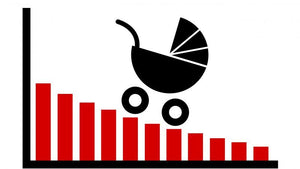Falling Fertility Rates in 2025: What the Latest Research Says
Mar 14, 2025
In 2024, the US fertility rate hit a historic low, with the general fertility rate decreasing by 3% from 2022. There are numerous factors that have contributed to this decline, such as:
Education and Empowerment of Women: More women are pursing higher education and entering the workforce, leading to delayed childbearing and smaller family sizes.
Improved Access to Contraception: Greater access to effective contraception allows individuals to make informed choices about family size and timing of pregnancies.
Environmental Factors: Endocrine-disrupting chemicals, which are found in everything from plastics, pesticides, cell phones etc. can interfere with the body’s natural hormonal balance and ability to conceive.
Rising Costs of Children: The economic burden of raising children, including housing, education and healthcare can deter families from expanding.
Social & Economic Shifts: Changes in societal norms, values and economic conditions, such as the prevalence of dual-income households, can also influence fertility decisions.
Delayed Childbearing: Individuals are marrying and starting families later in life, which leads to fewer children overall.
Increased Housing Costs: The rising cost of housing can make it more difficult for young people to form long-term relationships, families and physical space for bearing children.
Changes in Lifestyle Choices: Increased focus on careers and personal development can impact family planning decisions.
Inadequate Support of Working Parents: Lack of adequate and affordable support for working parents, such as paid parental leave and childcare, can make it difficult for couples to balance work and family life.
For these reasons, many individuals and couples are waiting until "geriatric maternal age" (over 35 years old) to start thinking about having babies - which comes with an annual decline in egg count and overall fertility. Currently, the standard medical practice for infertility is to refer patients to Assisted Reproductive Technologies such as IUI and IVF. While these treatments can increase chances of conception, they also come with invasive and painful procedures, possible severe side effects and out of pocket costs up to $30,000-$50,000 depending on how many cycles are attempted. The inability to conceive and the traditional referral to ART leaves many couples feeling unseen, vulnerable and powerless.
As a result, there is a need for natural, non-invasive and affordable products that increase chances of conception without the hefty price tag and the physical and emotional toll of ARTs. One of the key fertility trends in 2025 is the demand for at-home conception products, such as conception cups and fertility supplements.
Ovarium Conception, a women-owned company founded by an APRN, recognizes this need. Ovarium's founder invented and patented the Ovarium Conception Cup to boost the body's natural conception process and increase chances of success. The Ovarium Conception Cup works by cradling sperm against the cervix for up to 12 hours after intercourse, without leakage - giving a maximum amount of sperm the maximum amount of time to reach the egg. The Ovarium Conception Cups, along with their Sperm-Friendly Lubricant with Male and Female Fertility Support Supplements, empower couples to take charge of their reproductive health while avoiding the risks associated with ART.
As fertility trends continue to evolve, the future of conception will likely involve a combination of innovative, natural, and personalized approaches. With the right tools, brands like Ovarium Conception can help couples can optimize their chances of conception while minimizing the need for invasive medical treatments.
www.ovariumconception.com
https://a.co/d/8j43UlH
https://academic.oup.com/humupd/article/30/2/153/7513427
https://www.cdc.gov/nchs/pressroom/nchs_press_releases/2024/20240525.htm#:~:text=For%20Immediate%20Release:%20April%2025%2C%202024&text=The%20general%20fertility%20rate%20in,consistently%20decreased%20by%202%25%20annually



